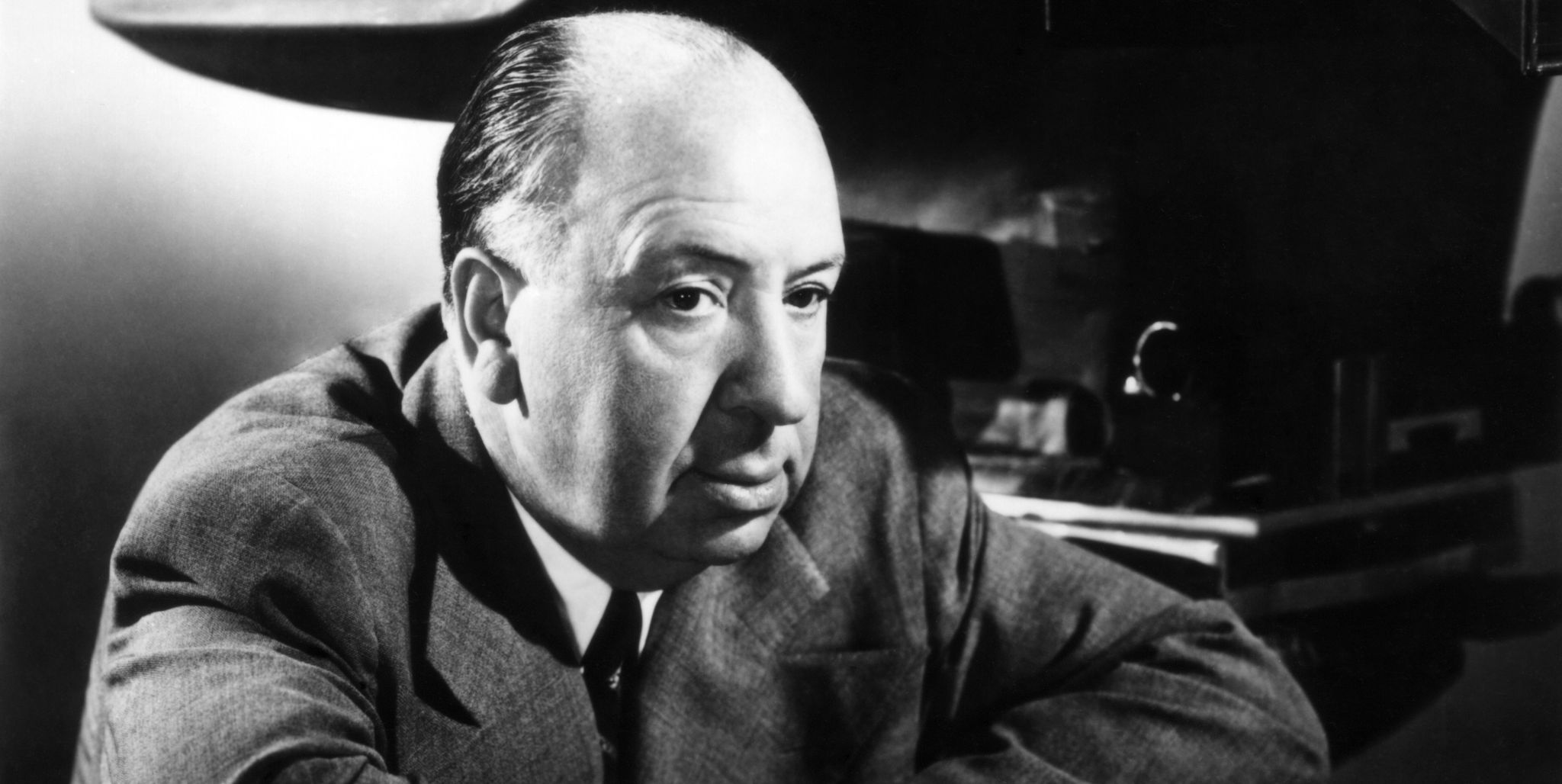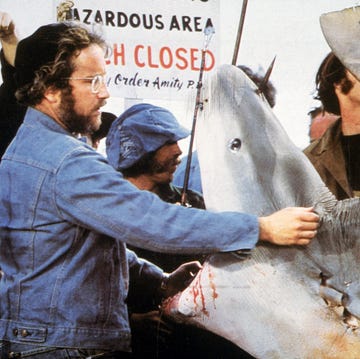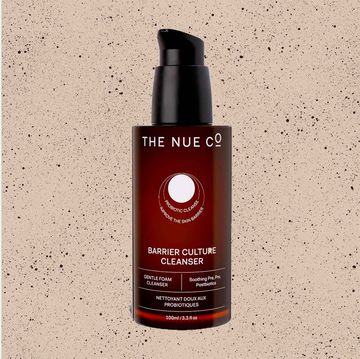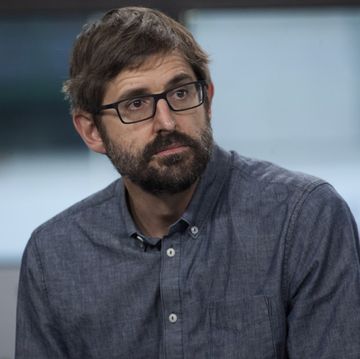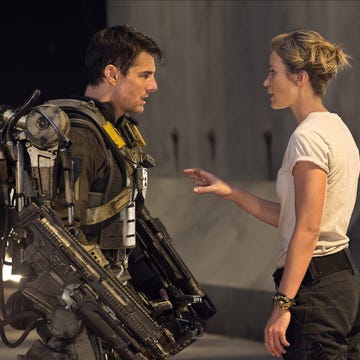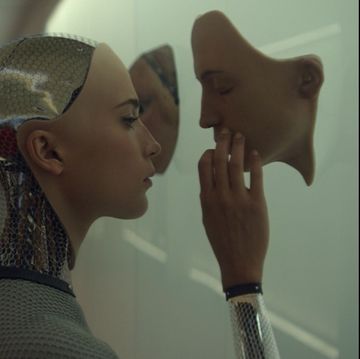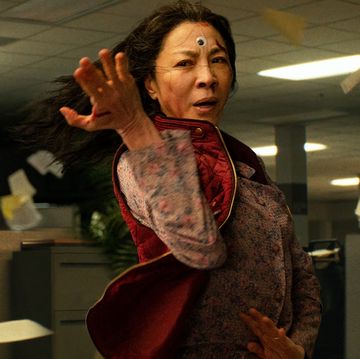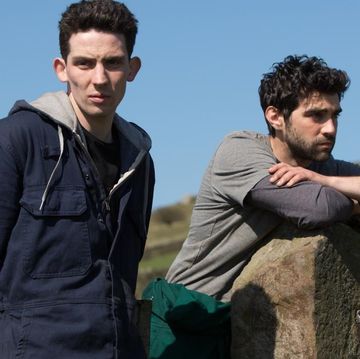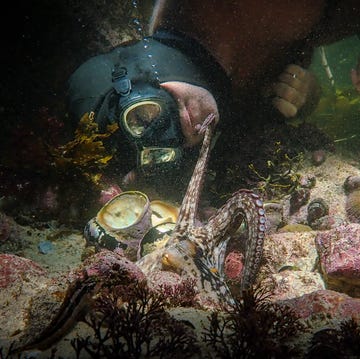Why, Francois Truffaut once asked Alfred Hitchcock, had the English director wanted to make Psycho in the first place? Hitchcock considered.
"I think the murder in the bathtub, coming out of the blue, that was about all."
Psycho turns 60 this week, and its influence and audacity continue to touch filmmakers. Edgar Wright wished many happy returns to a film he called "one of those rare, magical occurrences where genre film & high art collide. No matter how ripped off, parodied & endlessly Xeroxed it is, it still feels shockingly fresh every time I watch it. Undeniably one of the greats, to this day and forever more."
To celebrate, we've ranked the top end of Hitchcock's prolific output – he directed 53 features, and had a hand in many others – for a handy way into the back catalogue of a director who did more than almost anyone to form the grammar of modern cinema.
18. Suspicion (1941)
The playful, dashing charmer John Aysgarth (Cary Grant) starts putting the moves on Lina, then sweeps her off to elope for a wedding, a honeymoon, and the deeply disappointing revelation that he’s not quite the catch he says he is. Aysgarth’s broke, borrowing money from all over the place, and had designs on Lina’s rich dad’s money. The lies get bigger and bigger, and Lina starts to worry that Johnnie wants her dead. Grant leverages all of his charisma to make the caddish Aysgarth a believably dishy wrong ‘un, the black heart of this romance turned psychological thriller.
17. The Lodger: A Tale of the London Fog (1927)
Ivor Novello is the tall, secretive stranger who turns up at a house in London, at a time a murderer called ‘the Avenger’ is terrorising the city. Another woman is found dead, and the papers are abuzz. Have this normal family just taken in a serial killer? And can they stop him before he kills again? Since 1924 Hitchcock had been making films in Berlin, and the influence of German Expressionism is all over The Lodger, which ramps up the Gothic feel – there’s a fair bit of Nosferatu in the mysterious Lodger himself – to chilling effect.
16. Sabotage (1936)
A young woman in London has no reason to suspect that her cinema owner husband is at the centre of a terrorist ring which wants to disrupt life in the capital, but Scotland Yard are onto him. He plots to set off a bomb; the police try to catch up with him before he has time to. It’s a surprisingly brutal film, and unsparing when it comes to who cops it and who doesn’t. The sequence in which a young boy, Stevie, unknowingly transports a time bomb across London is one of Hitchcock’s best pure suspense scenes, ratcheting slowly to an unexpected climax.
15. Lifeboat (1944)
Adapted from a John Steinbeck story, this was the first of Hitchcock’s experiments with stories set in confined spaces. The whole thing takes place on a lifeboat carrying survivors from a U-boat attack on a passenger ship, a mixture of civilians, sailors and merchant seaman plus one surviving German. Suspicion and mania set in, as the survivors fight amongst themselves. It’s a thoughtful, sensitive (though the treatment of Joe, the single Black character, is patronising and crude) and slightly offbeat Hitchcock work, especially given his run of straight-ahead rollicking thrillers in the late Thirties and early Forties, but it deserves its recent reappraisal.
14. Frenzy (1972)
Hitchcock returned to film in Britain for the first time in 22 years for this late success. A murderer is terrorising London again – bit of a theme in Hitchcock’s films in the capital – and strangling his victims with a necktie. For all that it returns to the slyly funny murder-suspense mode of his Thirties and Forties films, and a loving homage to his Covent Garden roots, Frenzy is also a dirty, nasty little film. It was the first in which Hitchcock showed nudity, and its casual brutality sits at odds with its stylish look. Having inspired the New Hollywood directors with his expressive cutting, Frenzy feels like an attempt to reckon with the new school. It’s not always successful, but it is gripping.
13. Dial M for Murder (1954)
Retired tennis player Tony decides that the only way to deal with his wife Margot’s fling with an American writer is to have her killed and take her money. After blackmailing an old friend into doing it for him, Tony’s plan doesn’t go exactly to plan, but instead he manages to frame Margot for murder. She’s sentenced to hang. Can anyone save her? Like Rope, Dial M for Murder is based on a stage play, though it doesn’t lose any cinematic juice in the transfer as Rope sometimes does. The first half hour is a little slow to get moving, but once that's ticked past you're into a ruthlessly effective inversion of the whodunnit mystery, which gives Grace Kelly a lot to get stuck into as Margot.
12. Rebecca (1940)
Hitchcock’s first American project was a huge statement of intent: an adult drama which took the Gothic roots of Daphne du Maurier’s novel and added psychological complexity which the director had been yet to really nail to the suspense he’d already mastered. Eleven Oscar nominations, and Hitchcock’s position at the top of the cinema world, followed.
A young woman who doesn’t know much of the world (Joan Fontaine) marries Maxim de Winter (Laurence Olivier, on icily magnificent form) who spirits her away to his massive country pile. The housekeeper, Mrs Danvers, is still very much a fan of the first Mrs de Winter, though. The memory of Rebecca haunts the young woman, and the events of the past keep returning to wreak havoc at Manderley again.
11. Notorious (1946)
Things rarely came together for Hitchcock quite like they did on Notorious: it features a top-drawer cast headed by Cary Grant and Ingrid Bergman, a plot about atomic secrets being stolen just as the chill of the nuclear age began to settle, and some of his most innovative filmmaking. There’s one of his great shots, a slow zoom down from a balcony into a party, down and down and down, finally focusing in on Bergman’s hand frantically squeezing a key. She plays Alicia, the daughter of a Nazi spy who’s recruited by Grant’s government agent to track down fugitive Nazis in South America with a mix of spying and judicious marriage.
10. German Concentration Camps Factual Survey (1945)
"At the end of the war," Hitchcock told Henri Langlois in the Seventies, "I made a film to show the reality of the concentration camps, you know. Horrible. It was more horrible than any fantasy horror."
While Hitchcock didn’t direct this documentary of the liberation of Bergen Belsen in 1945 – his month-long involvement as 'treatment advisor' only started after all the reels had been filmed – it’s his advice to avoid editing in favour of long, slow pans and unbroken shots which gives the film its air of solemn, truthful witness.
It goes some way beyond its initial goal of simply proving beyond doubt that the atrocities happened. Shelved after screenings in September 1945 but restored in 2017, it’s lost none of its impact. It is deeply, gutturally, viscerally shocking and sickening. Hitchcock suggested foregrounding haunting images which evoke the human weight of the Nazi atrocity: piles of wedding rings, of glasses, of toothbrushes.
"Nobody wanted to see it," Hitchcock told Langlois. "It was too unbearable. But it has stayed in my mind all of these years."
9. Shadow of a Doubt (1943)
Even 20 years after leaving Germany, the angular shadows of the Expressionist filmmakers stretch long over this psychological thriller. Young, bored teen Charlotte is delighted when her uncle Charlie comes to stay, showering his family with presents and opening a bank account with a gigantic wedge. Two men are on Charlie’s tail though, and things don’t add up about him. Where did he get a locket he gave to Charlotte? Why won’t he let anyone take his picture? Could he be, as a detective tells Charlotte, the Merry Widow Murderer? Hitchcock said several times that it was his favourite of his own films, and its central message – “Love and good order is no defence against evil," as Hitchcock put it – is still haunting today.
8. The Birds (1963)
“Sooner or later,” Roger Ebert once wrote, “every Hitchcock woman was humiliated.” The Birds is perhaps the most extreme example. One of Hitchcock’s most parodied and mimicked films was absolutely pilloried when it arrived, and it’s also impossible to talk about The Birds without mentioning the hell that Hitchcock put star Tippi Hedren through on set, from making unwanted and inappropriate advances to swapping fake birds for real ones without telling her. It endures, though, because of its careful shuffling of that strain of sadism and the restrained, haunted editing which separates the great orgies of horror that come when the birds attack. During a weekend at the beach, a gull suddenly attacks a young woman. It’s just the start of an unexplained and unstoppable avian siege.
7. Strangers on a Train (1951)
Perhaps the most elegant of Hitchcock’s one-line set-ups, Strangers on a Train is about two men who agree to kill on each other’s behalf while providing each other with an alibi. Or rather, one of them agrees to, and tries to force the other into holding up his end of a bargain he didn’t agree to.
Trains in Hitchcock’s films are generally hotbeds of sex and death, and places where coincidence and the random co-mingling of people leads to spiralling consequences. Strangers on a Train uses all of that, and ladles on the idea of doubles and mirrors as well as adding a sexual ambiguity to Bruno and Guy’s relationship. At its root, it’s about an ordinary man desperately trying to make decisions while the walls close in.
6. Vertigo (1958)
Generally Vertigo dukes it out with Citizen Kane for the title of the greatest film ever made when it comes to big polls, but as this is a very small poll (sample size: me) it’s going sixth. The genre-hopping noirish Gothic psychological horror-thriller follows Scottie (Jimmy Stewart), a retired policeman dragged into a surveillance operation by an old friend who’s worried about his wife Madeleine (Kim Novak). Gradually, Scottie becomes obsessed with her, but tragedy strikes again. Scottie’s obsession won’t leave him, though. Bernard Hermann’s spiralling, circling score ramps up the sense of repetition and dream-like entrapment. For a thriller, it’s an oddly oblique film which invites all sorts of readings but always feels slightly out of reach.
5. North by Northwest (1959)
If Cary Grant had been chased across that cornfield by Hitchcock’s first choice of threat, cinema might look very different. He had originally wanted a tornado, before being talked down by writer Ernest Lehman.
“I just can't tell you who said what to whom,” Hitchcock said later, “but somewhere during that afternoon, the cyclone in the sky became the crop-duster plane.”
Cary Grant is Roger Thornhill, an advertising exec who, in another case of mistaken identity, is picked up by spies and nearly murdered. While trying to work out who exactly he’s been mistaken for, he’s framed for murder too. He’s on his own, and has to work out what this spy ring is trying to steal from the US while avoiding being killed himself. This glossy, globetrotting thriller is the peak of Hitchcock’s mainstream and critical successes. It pretty much invented James Bond too.
4. The Lady Vanishes (1938)
Iris (Margaret Lockwood) is heading back to England from central Europe to get unhappily married when she gets bonked on the head by a falling plant pot. She wakes on the train, and makes friends with a little old lady. She has a nap (not recommended on a concussion, but anyway) and the little old lady’s gone. Not only that, but everyone on the train swears blind she was never there at all. What’s going on? Michael Redgrave’s Gilbert is a wry leading man, and cricket-obsessed Charters and Caldicott add more comic relief, but behind the jaunty tone there are oddly prescient murmurings of a war in Europe.
3. Psycho (1960)
“[Psycho] was intended to make people scream and yell and so forth," Hitchcock said in 1964. "But no more than screaming and yelling on a switchback railway… so you mustn't go too far because you want them to get off the railway giggling with pleasure.”
That’s not quite how Psycho landed. Following the slick, colourful, globetrotting North By Northwest, Psycho is a pulpy, lo-fi black-and-white flick set in rural Nowheresville. Some critics hated it; The Observer’s reviewer, CA Lejeune, walked out and promptly resigned in protest at it. Another called it “a blot on an honourable career”.
The public, though loved it. In part that was because it was subversive, not just in its violence (though it did single-handedly invent the slasher) but in its portrayal of sex, voyeurism, and, oddly, being the first American film to show a flushing toilet.
For all Psycho’s legendary horror, and the frenzy of the shower scene, its opening is mundane. A woman makes off with some embezzled money, and hides out in a motel to work out what to do next. Suddenly, though, it starts to thrash through the gears: a domineering mother, a creepy young man who keeps eating candy corn, a murder, and a past that he can’t escape.
2. The 39 Steps (1935)
Hitchcock’s first absolute hands-down masterpiece mints almost all of the tics which would define his later great thrillers. In Richard Hannay (Robert Donat), it’s got a hero who’s accused of a murder he didn’t commit, and has to uncover shadowy forces to clear his name while running from police. What is the 39 Steps? And why does it want him dead? It’s got a fizzing, funny script, and crackling sexual tension between (Donat and Madeleine Carroll). And, in its most famous bit of editing – a woman turns to scream on finding a corpse, but the shriek that comes out of her mouth is the whistle of the train Hannay has jumped on to Scotland – there’s more verve, style and mystery than most other entire films.
1. Rear Window (1953)
The allure and danger of voyeurism runs through Hitchcock’s work, but in Rear Window it’s front and centre. Jimmy Stewart is the charmingly cantankerous ‘Jeff’ Jeffries, a frustrated news photographer who’s out of action thanks to a broken leg and a cast up to his hip. To keep himself occupied, he watches vignettes play out through the windows of apartments in his block.
There’s the newlyweds, a struggling songwriter, a lonely woman desperate for love… and a wife who suddenly disappears. Does the husband have blood on his hands? Jeff and his on-off girlfriend Lisa (Grace Kelly) investigate, and are soon in way over their heads. It’s a witty, sprightly, romantic, morbid, paranoid blend of all Hitchcock’s strongest suits, and a sly reminder that you, the cinema audience, are as much a peeping Tom as Jeff.
Like this article? Sign up to our newsletter to get more articles like this delivered straight to your inbox
Need some positivity right now? Subscribe to Esquire now for a hit of style, fitness, culture and advice from the experts
